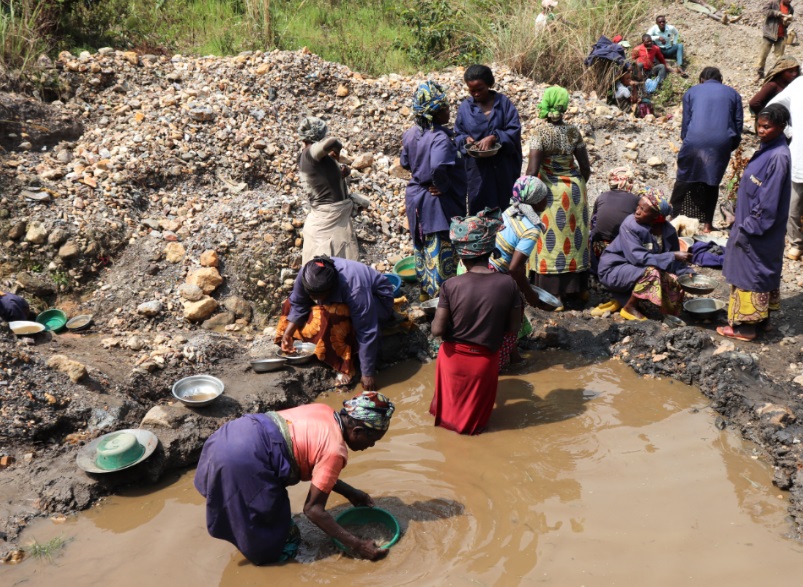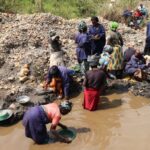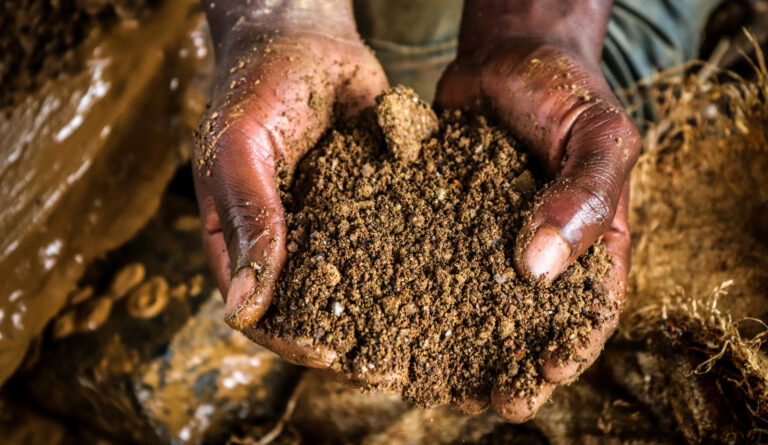
In the east of the DR Congo, in the provinces of North and South Kivu, the vast majority of gold mining is carried out on an artisanal basis. The Justice and Peace teams went to visit a mine in South Kivu to try to trace the path of the gold extracted from it and thus trace the supply chain.
Pour rejoindre le site d’exploitation de Nyamurhale, situé à quelques dizaines de kilomètres de la ville de Bukavu, plusieurs heures de voiture ont été nécessaires en raison du mauvais état de la voirie. Nous arrivons finalement sur le site. Celui-ci est “certifié” ou “propre” c’est-à-dire qu’il respecte un certain nombre de critères dans les conditions d’exploitation. Par exemple : le fait qu’aucun enfant, ni aucune femme enceinte [1]The ban on pregnant women has raised many issues regarding women's rights. Many sites have banned access to women under the pretext that they could be… Continue reading cannot work as a digger, or the absence of armed men on the site (armed or military groups).
THE SUPPLY CHAIN
More than 300 diggers work tirelessly to exploit a prolific vein of gold that passes through here. As we arrive at the site, a handful of diggers come forward to meet us and tell us: “the others are underground currently, because we are on working hours”. It is hard to imagine that several hundred men are literally under our feet, several meters underground, at the very moment of our visit.
And yet: to recover the earth which contains the precious metal, workers dig galleries, using very rudimentary equipment, which go hundreds of meters underground. No structure is really established to maintain the galleries and landslides are therefore frequent, bringing with them the death of the diggers who found themselves trapped. The depth of the galleries means that air is often lacking. It also happens, in the event of rain, that water enters the corridors and stagnates, further weakening the strength of the galleries. There are pumps (water or air) to reduce these risks, however, the equipment is lacking most of the time. The Nyamurhale site, for example, only has one air pump for 300 diggers and does not have a water pump.
Artisanal diggers therefore work in difficult and dangerous conditions. Without work equipment or protection, accidents are numerous. Respiratory illnesses linked to the continuous inhalation of dust and the humidity of the galleries are the daily lot of workers. Despite the difficulty of the work, the salaries are very low. They fluctuate depending on the quantities found which vary from one day to the next, making the lives of workers very precarious. On average, we can say that a digger earns between 2 and 10 dollars per day (or ± 160 dollars per month). There is no union and artisanal diggers, despite recent legislative changes, do not really have the opportunity to assert their rights or see their working conditions change.
Les creuseurs s’enfoncent toute la journée dans les galeries souterraines pour y extraire de la roche/terre. Celle-ci est collectée dans de grands sacs de toile qui partent ensuite au “centre de traitement”. Là, les travailleurs vont mouiller, puis broyer la terre à l’aide de gros cailloux pour en faire ressortir les paillettes d’or. En effet, la terre au contact de l’eau devient boue, mais les paillettes ne peuvent pas s’écraser. On les voit apparaître au milieu de ces tas de boue. Puis la boue est passée au tamis, lavée, et il ne reste que les paillettes d’or. À ce moment- là, l’or est séché (grâce à un petit feu), puis séparé des déchets et autres métaux restants à l’aide d’un aimant. On en mesure ensuite la teneur. L’or est alors fin prêt pour la vente.
Gender focus – Dans les sites miniers chacun a son rôle : le creusage est d’ordinaire plutôt réservé aux hommes pendant que les femmes s’occupent des activités de concassage, de lavage et de triage des minerais. On les appelle les “mama twangueuses”. Généralement, les femmes sont moins rémunérées que les hommes pour leur travail, et sont moins bien informées sur leurs droits comme le souligne l’organisation IMPACT : “moins de 40 % des femmes sondées savaient que la RD Congo disposait d’un code minier, comparativement à 85% des hommes. Environ 90 % des femmes sondées ont indiqué n’avoir jamais reçu de formation sur l’exploitation, la sécurité et les lois minières.” De plus, il est difficile pour ces dernières de formuler des revendications, d’exprimer des préoccupations ou tout simplement de participer à la prise de décisions car elles sont le plus souvent exclues des systèmes de gestion communautaire des mines artisanales [2]Impact, “Les femmes dans l’exploitation minière artisanale et à petite échelle en RDC”, 2017 ; IPIS, “La place de la femme dans l’exploitation minière artisanale dans le … Continue reading.
Once the gold harvesting and processing process is complete [3]Mercury is used on approximately 10 to 15% of gold mines according to IPIS. Mercury has dramatic consequences on fauna and flora because it pollutes rivers and the air. Additionally, the… Continue reading, a long journey opens for the export of the material. So, cooperatives qui regroupent les creuseurs vont vendre les “récoltes” de la journée à des “négociants”. Avec l’avènement du nouveau code miner, les creuseurs sont aujourd’hui obligés de se regrouper en coopératives [4]Pour en savoir plus sur le code minier voir notamment : Justice et Paix, “Code minier en RD Congo : les enjeux de la réforme”, Juillet 2019 // Information sur les coopératives … Continue reading. Several cooperatives can be present on a single mining site, which increases the risk of conflict. In Nyamurhale for example there are more than 5 cooperatives on a single site. Moreover, the latter are often cooperative in name only. They lack professionalism. Cooperatives need to improve so that diggers actually see the benefit of forming a cooperative and paying a fee for this (with therefore real protection of their rights).
Only the traders will be authorized, thanks to a card that they buy each year from the Congolese authorities (between 300 and 500 dollars), to then sell the gold at counters located in town. They are the ones responsible for transporting precious resources. The latter is generally done by road (with the risk of encountering roadblocks and having the goods taxed or stolen).
The purchase price of gold is determined by international markets, far from the reality of artisanal diggers, who are nevertheless the first links in the chain, and without whom this gold would not be available. The purchase price of gold varies from day to day. These fluctuations have repercussions, among other things, on the salaries of diggers at the end of the chain.
On the Nyamurhale site, during our visit, traders buy from the cooperatives for 42 dollars per gram of gold. It will then be resold for 55 dollars at the Bukavu purchasing counter. [5]These figures come from interviews carried out on the Nyamurhale site in July 2019..
THE international buyers then come to obtain supplies from export counters. The minerals leave the country in raw form, that is to say without having been transformed and therefore without much added value. The raw material will increase in value as it progresses through the processing chain. The majority of minerals are exported to Asian countries, where processing and assembly factories for electronic devices are located. The finished products are then exported throughout the world and more particularly to Europe and the United States. In Belgium, we also find Congolese gold – in jewelry for example or even in our electronic objects.
These different stages and intermediaries together constitute what we call the “supply chain”. That is to say all the stages of the chain through which a resource will pass to be transformed into a final consumer good: from the mine, through transport, sale and transformation... until end use by the consumer.
ILLICIT TRADE IN MINERALS
It is difficult to precisely assess the quantity of minerals produced in DR Congo. The sector suffers from a lack of transparency and official figures seem largely underestimated compared to the quantities actually produced each day in the mines. According to official figures provided by the Bukavu Ministry of Mines during our visit, the South Kivu region produced in 2018 the equivalent of 1.5kg of gold per year. However, we know that production is much higher. This discrepancy can be explained by the fact that minerals are also exported through unofficial channels and that a vast smuggling network exists. In South Kivu, the fraud of illegally exported minerals is estimated at approximately 15% of the total mineral production in the province. For gold, this figure climbs to more than 98% [6]It is almost impossible to establish the origin of the gold. In fact, gold can be melted, mixed, and remelted endlessly. Which makes it almost impossible to trace. These figures are… Continue reading.
Illicit mineral trade is therefore a major problem. Illegal export fuels, on the one hand, a climate of insecurity which destabilizes the Great Lakes region as a whole. In DR Congo, the absence of effective border control prevents sovereign control over the quantities exported and the taxes which, legally, should result from them. The province of South Kivu borders three other countries, which facilitates the illicit trade of minerals, particularly via the Ruzizi River (towards Burundi), via Lake Kivu (towards Rwanda) and via Lake Tanganyika. (towards Tanzania).
On the other hand, fraud and corruption within the country itself contribute to the enrichment of a few to the detriment of the population – since the State is not able to collect taxes and re-inject this money into favor of the development of the country.
Corruption surrounding the management of natural resources is not only located at the highest levels of the State but is also a common practice within the various administrations and State services where poorly paid civil servants try to take advantage of their function, in particular through the embezzlement or illicit collection of taxes.
And businesses participate and benefit from it! In addition to corruption and fraud, another phenomenon reinforces the plundering and spoliation of national wealth: the granting by the State of advantageous tax conditions to mining companies. These measures are intended to attract private investment to the country. We thus end up with companies that make millions, even billions, of dollars in profits and which are exempt from tax for 10 or 20 years. These practices generate an obvious shortfall for public finances and therefore for the population.
Face à cette réalité problématique, il existe aujourd’hui une volonté de certains acheteurs internationaux de s’approvisionner en ressources “propres”, et donc par la force des choses, une nécessité pour les pays producteurs de pouvoir répondre à cette demande. Différentes initiatives ont déjà vu le jour à travers le monde en faveur d’un renforcement de la transparence [7]Transparency of a supply chain involves collecting data on the good, the stakeholders and the stages that this good goes through throughout the chain, then … Continue reading of the extractive sector for responsible sourcing of natural resources. These systems are based in particular on traceability mechanisms allowing a buyer to know where the minerals purchased come from and thus to ensure that they are exploited in mines which meet certain social, environmental and ethical criteria.
La traçabilité repose essentiellement sur la certification de certains sites miniers et sur l’étiquetage des sacs contenant les minerais au gré des différentes étapes de la chaîne d’approvisionnement. Ces mécanismes sont complexes à mettre en œuvre et connaissent aujourd’hui de nombreuses limites. L’opacité des réseaux d’exportation notamment reste un enjeu de taille, tout comme les risques de contamination au long du parcours (c’est-à-dire de mélange de minerais “propres et certifiés” avec d’autres qui ne le sont pas). Et le degré de fiabilité de la traçabilité est ainsi relatif.
Finally, it is also important to keep in mind that if the initiatives and regulations mentioned have the merit of realizing a desire for improvement in mining, they also sometimes induce unanticipated biases. Thus, the construction of the Dodd-Frank Act in the United States in 2010 had, for example, created a de facto embargo on Congolese minerals, thus depriving 10 million Congolese who depend - directly or indirectly - on income derived from exploitation of resources. Nevertheless, this law was the trigger for the gradual establishment of certified “green” mining sites.
THE FINAL RECIPIENTS: BELGIUM CONCERNED?
The Democratic Republic of Congo is often described as a “geological scandal” as its soil and subsoil are rich in natural and mineral resources. Many of these resources are strategic and highly sought after by other countries (notably the European Union and therefore Belgium) in the context of the energy transition and the digitalization of our societies. Given their diverse uses across multiple sectors, mineral resources (including gold) play a vital role in the global economy.
It would therefore be right for them to represent a source of both economic and social development for countries that are rich in them. And this is where the paradox lies: if the presence of these innumerable resources on its territory represents a considerable advantage for the DR Congo, the fact remains that it is one of the most poorest in the world. The DR Congo has experienced dark years of crisis and bloody conflicts which resulted in the deaths of millions of people. And tensions continue in various parts of the country. The presence of these natural resources is not unrelated to this tumultuous history because Congolese resources attract covetousness and arouse tensions with the countries of the region.
It is crucial that we realize the role we can play – as importing countries, but also as citizens – in improving mining conditions in DR Congo. The exploitation of resources should be better regulated to be able to fully contribute to improving the living conditions of the population. Civil society in DR Congo is very active on these subjects and regularly formulates recommendations for national and/or international political decision-makers. It is essential that the voice of those who struggle and work as close as possible to these realities can be listened to and integrated into the reflections.
Clara Debeve.
Attachments
Notes[+]
| ↑1 | The ban on pregnant women has raised many issues regarding women's rights. Many sites have banned women from accessing them under the pretext that they could be pregnant. |
|---|---|
| ↑2 | Impact, “Les femmes dans l’exploitation minière artisanale et à petite échelle en RDC”, 2017 ; IPIS, “La place de la femme dans l’exploitation minière artisanale dans le territoire de Masisi : législation et pratique du terrain”, 2018 |
| ↑3 | Mercury is used on approximately 10 to 15% of gold mines according to IPIS. Mercury has dramatic consequences on fauna and flora because it pollutes rivers and the air. In addition, processing gold is generally a task reserved for women and children, and mercury is extremely toxic. |
| ↑4 | Pour en savoir plus sur le code minier voir notamment : Justice et Paix, “Code minier en RD Congo : les enjeux de la réforme”, Juillet 2019 // Information sur les coopératives recueillies au cours d’interviews réalisées sur le site de Nyamurhale en juillet 2019 ; IPIS, “Cartographie des zones minières artisanales et des chaînes d’approvisionnement en minerais dans l’est de la RDC. Impact des interférences des groupes armés et des initiatives d’approvisionnement responsables”, Mai 2019 |
| ↑5 | These figures come from interviews carried out on the Nyamurhale site in July 2019. |
| ↑6 | It is almost impossible to establish the origin of the gold. In fact, gold can be melted, mixed, and remelted endlessly. Which makes it almost impossible to trace. These figures come from interviews conducted in Bukavu in July 2019. |
| ↑7 | La transparence d’une chaîne d’approvisionnement suppose de recueillir des données sur le bien, les intervenants et les étapes que traverse ce bien tout au long de la chaîne, puis d’en rendre compte, telles que le requièrent les lois régionales et internationales. Il s’agit notamment de rendre publics les comptes des lacunes et des manquements constatés dans une chaîne d’approvisionnement, ainsi que des mesures prises pour contrer les risques ciblés. Cette définition est issue du rapport Impact “Or juste. Acheminer de l’or artisanal légal, traçable et libre de conflit jusqu’aux marchés internationaux”, Avril 2018 |







